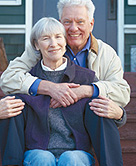
FRIDAY, Aug. 31 (HealthDay News) — Baby Boomers are in the mood for shacking up, and not just for a little while: The percentage of older Americans who are living together has skyrocketed in recent years, and new research finds that those who cohabit are most likely to stay that way instead of splitting or getting married.
“Cohabitation is really taking hold across the generations. It is now a viable alternative to marriage, even to older adults,” said Susan Brown, the study’s lead author and co-director of the National Center for Family and Marriage Research at Bowling Green State University in Ohio.
Although the overall number of older people who are living together is still small compared to those who are single or married, it more than doubled in 10 years: About 2.75 million people over the age of 50 were cohabiting in the United States in 2010 compared to 1.2 million a decade earlier, according to the research. Among those aged 50 to 64, 12 percent of single people were living together in 2010, up from just 7 percent a decade earlier.
Brown and her colleagues sought to understand cohabitation in older adults, who as a group are avoiding marriage more than in the past. About a third of Baby Boomers — born from 1946 to 1964 — are unmarried today, compared to just 20 percent of people who were their age in 1980.
“There’s been this rapid acceleration of being single, and more single people means more people at risk of cohabiting,” Brown said. “We were just interested in figuring out the patterns of these unions.”
The new study, which appears in the August issue of the Journal of Marriage and Family, used data from the 1998 to 2006 Health and Retirement Study and the 2000 and 2010 Current Population Surveys to track more than 3,700 older unmarried people and nearly 400 people who cohabited. The people were aged 51 to 75; a small number of same-sex relationships weren’t included.
The findings suggest that people who live together have remarkably stable relationships, Brown said.
“They seem to be a long-term alternative to marriage,” she said. “That’s not at all what we see for younger people, for whom cohabitation is a stepping stone to marriage, a way to test out the relationship.”
The study found that death is more likely to break up an older cohabiting couple than a relationship split or marriage. And among those who are single, their likelihood of cohabiting is equal to their likelihood of getting married.
Living together can have financial benefits for older people, Brown said. Widows or widowers don’t have to give up their spouses’ Social Security benefits if they don’t get married, and unmarried people can avoid taking on the medical debts of their partners, she said.
Also, she said, “many women aren’t interested in getting remarried later in life. They say, ‘I took care of one man, and I’m not interested in taking care of another.'”
The study results reflect the findings of Stephanie Coontz, a professor at Evergreen State College in Olympia, Wash., and author of “Marriage, a History: How Love Conquered Marriage.”
“For young people, social factors such as economic and educational status are very big predictors of who marries and who cohabits,” she said. In contrast, older people may lack an incentive to get married.
“They no longer are at the stage of life when they feel like they want or have to have a big wedding — to please family, to announce their commitment to the world, to protect future children or to accumulate wedding gifts,” Coontz said. “Second, there are some real disincentives for some: complicated finances, prior experience with the hassles of dissolving a marriage if something were to go wrong.”
What about that old stigma of “living in sin”?
“The stigma has largely disappeared for most Americans, except for small pockets of people,” Coontz said. “Older Americans may be more likely to disapprove of cohabitation in the abstract, but they also have fewer relatives alive to shock and offend. Possibly those two tendencies balance each other out.”
More information
For background on divorce, try the U.S. National Library of Medicine.

